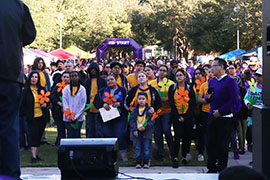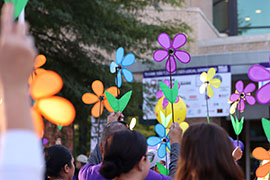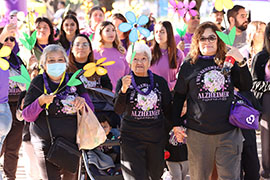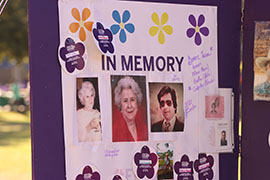- Slug: BC-CNS-Border Alzheimer’s,1600 words.
- 6 photos, graphic available (thumbnails, captions below)
By Angelina Steel
Cronkite News
LAREDO, Texas – In a small border community in Texas, locals attending the city’s eighth annual Walk To End Alzheimer’s carried large pinwheel-shaped flowers made of brightly colored plastic, each color representing a different designation for those affected by the disease.
The orange flowers represented people who support the cause of Alzheimer’s research, yellow flowers were held by those caring for someone battling Alzheimer’s; people who have lost someone to the disease carried purple flowers and blue flowers were carried by those currently battling it.
Texas border communities have higher rates of Alzheimer’s than anywhere else in the state. Laredo, with a population of about 256,000, is a border community located across from Tamaulipas, Mexico. According to a study released by the Alzheimer’s Association, Laredo is tied with El Paso, another border community, for the highest Alzheimer’s rate in Texas and is ninth in the nation: 15%.
Adriana Nunemaker, executive director of the University of Texas Education and Research Center at Laredo, says the program is currently working on two research projects. One is looking at how COVID-19 affects Alzheimer’s symptoms, and the other focuses on the aftereffects COVID-19 may have on patients with Alzheimer’s.
While these two projects are new, Nunemaker says that the facility established itself as the UT Center at Laredo in 2021, before the alarming 2023 statistic came out, because researchers and locals had been noticing the high rate of cases for a long time.
“They started to see a prevalence,” Nunemaker said. “Long before the statistic came out there was a call for action. That action was, ‘We need a piece of Biggs here (the Biggs Institute provides dementia care and research) so that they can be taking care of our patients.’”
Subodh Kumar, a research assistant professor at Texas Tech University Health Sciences Center at El Paso, says there are several reasons Hispanic communities like Laredo and El Paso suffer from higher rates of Alzheimer’s, including poverty, low education, poor environment, poor diet, lack of physical exercise and stress. The main problem for treating the disease in these communities is lack of research and health care.
“The Texas border is very long and there are very few research hospitals and research-oriented hospitals,” Kumar said.
Health care shortage
As in most of the country, Laredo is facing a health care shortage contributing to the high percentage of Alzheimer’s patients not getting adequate treatment.
“Populations living on the U.S.-Mexico border have a lack of outreach, like health care workers,” Kumar said. “Sometimes patients can visit the hospital, but it is very hard to do a follow-up on those patients.”
Joe Arciniega, a local from Laredo and member of the Alzheimer’s Association board of directors, says the number of Alzheimer’s cases by county in Texas just came out in July. Before then, there was no way to tell the specific number of cases affecting the community.
“We were able to tell how many people in the state of Texas … we were never able to go deeper than that because it’s taken time with legislation that we got passed years ago, identifying Alzheimer’s as a national health concern versus an aging issue,” Arciniega said.
He said despite legislation being an important first step toward proper research, not enough is being done for communities of color. Arciniega said Alzheimer’s impacts Hispanics one-and-a-half times more — and African Americans two times more — than non-Hispanic whites, yet those groups are critically underrepresented in research.
“It’s critical that the research include Hispanics and African Americans … (who) have been unbelievably underrepresented in clinical trials,” Arciniega said. Without them in the studies, he said, “What’s the point of testing, doing research on a disease that disproportionately impacts people of color?”
Arciniega says he’s been working with the Alzheimer’s Association in Laredo for eight years. It wasn’t until his father got diagnosed with the disease that he realized how medically underserved Laredo is.
“My father was in San Antonio when he was afflicted with Alzheimer’s in 2010. And I was able to keep him over there for about three years until I couldn’t do that anymore, because I was going back and forth and his disease progressed so much,” Arciniega said. “I finally brought him here. And that’s when I realized how there were no resources, no information.”
Similar to others experiencing the disease, Arciniega’s father became aggressive, extremely agitated, and, since he was mobile, he would wander out of the home.
Arciniega said he was lucky enough to be able to put his father in managed care but some people in Laredo don’t have the means to do that. They often have to make very difficult decisions regarding their loved ones’ care.
“I can’t even really fathom the choices that they have to make, because it’s just so heartbreaking,” Arciniega said. “I mean, they have to work, they have to leave the home. … You can probably draw your own conclusions of what too many people in Laredo have had to do and the choices they’ve had to make with their loved ones, leaving them alone, locking them in a bedroom. Things that are just kind of inconceivable, actually.”
Support needed for care and research
Alzheimers is an expensive disease. According to the Alzheimer’s Association, full-time at home care costs about $1,145 per week (40 hours of care per week) or about $60,000 per year. Assisted living facilities cost about $57,289 per year. A private room in a nursing home: $115,007 per year.
The association says the Walk to End Alzheimer’s, which is held annually in over 600 communities nationwide, is the world’s largest event to raise awareness and funds for Alzheimer’s care, support and research.
Maryjanne Martinez, a student at Texas A&M International University in Laredo, attends the walk every year in support of her grandfather, who died from the disease in 2020.
“Even though he died I still like to come and support him. I always take a flower and it’s nice to see everybody else with theirs,” Martinez said. She held a purple flower while her boyfriend, standing next to her, held an orange one to show support.
She says her grandfather’s fight against Alzheimer’s lasted five years but the memories of taking care of him live on. Her entire family of four was in charge of caring for her grandfather. Her task was making sure he wouldn’t leave the house when she was home from school.
“It progressed very quickly,” Martinez said. “I watched him go from the amazing man he once was to fragile so quickly.”
The University of Texas Education and Research Center at Laredo is a teaching center that supports University of Texas institutions in the delivery of research and clinical and community engagement activities in Laredo and the surrounding South Texas region. It has partnered with the Biggs Institute for Alzheimer’s and Neurodegenerative Diseases to simultaneously conduct research and provide care to the Laredo community.
The Biggs Institute offers neurology, neuropsychology/diagnostic testing, genetic counseling and testing, referrals to neurosurgery and speech, physical and occupational therapy, online support groups and resources, as well as advanced treatment with clinical trials.
The Walk to End Alzheimer’s is put on every year by a group of volunteers known as committee members.
Patty Bruni has been involved with the committee since her mom started to show the beginning stages of Alzheimer’s.
Before she was involved and taking care of her mother, she said she hardly knew anything about the disease.
“A lot of times people think it’s just an old person’s disease,” Bruni said. “As we’ve brought awareness, more and more people are starting to come out and speak about it. And lo and behold, there’s a lot of caregivers in our city that need support, just like I did when I began my journey.”
Bruni’s mom was diagnosed with dementia in her late 70s. Now she’s 93 and being cared for by family and assistant caregivers.
Bruni said she has taken care of herself over the years by attending support groups specifically designed for those caring for somebody with Alzheimer’s. She said the Alzheimer’s Association also has a toll-free number that she calls when her mom is behaving in a way she doesn’t know how to handle.
“They also have a toll-free number, or 1-800 number, that at the beginning I used to call it every single day, because certain behaviors might arise that I didn’t know how to deal with,” Bruni said. “They would walk me through and explain to me what I should be doing.”
Bruni attributes the walk for bringing awareness about much-needed caregiving support in Laredo. She said the first walk had just a handful of people and raised around $30,000. This year, they had over 1,000 attendees and raised over $142,000.
“At the beginning there were no resources, to be honest, with the support group. And as we’re doing the walk every year, more and more resources started arising,” Bruni said. “I think it’s (the walk) brought awareness to the community. The walk has grown so much from the first time to now.”
The walk this year was flooded with many different colored flowers. One flower, which was presented by Jerry Garza, a co-host of the event and news director for the local TV station KGNS, stood out from all the rest.
The white flower represents those who survive the currently incurable disease.
“One day we will be able to add the white flower to the garden,” Garza said. “Right now, as we all know, there is no cure for Alzheimer’s. But I have hope we will get there.”
For more stories from Cronkite News, visit cronkitenews.azpbs.org.
^__=
Hundreds of locals gather at Texas A&M International University for the eighth annual Walk to End Alzheimer’s in Laredo, Texas, on Nov. 4. (Photo by Angelina Steel/Cronkite News)
Walk attendee Rachel Aguilar holding a purple flower and listening to an event speaker at the annual Walk to End Alzheimer’s in Laredo, Texas. Purple flowers are carried by those who have lost someone to Alzheimer’s. (Photo by Angelina Steel/Cronkite News)
The color of each flower carried by attendees at the annual Walk to End Alzheimer’s in Laredo, Texas, on Nov. 4, represents a different relationship to Alzheimer’s disease. (Photo by Angelina Steel/Cronkite News)
Participants in the annual Walk to End Alzheimer’s in Laredo at Texas A&M International University on Nov. 4. Blue flowers are held by those living with Alzheimer’s. (Photo by Angelina Steel/Cronkite News)
Pictures of relatives lost to Alzhemer’s disease were posted on a memorial at the annual Walk to End Alzheimer’s in Laredo, Texas, on Nov. 4. (Photo by Angelina Steel/Cronkite News)
Jerry Garza, a co-host of the event and news director for KGNS-TV, instructing the crowd to raise their flowers before the start of the annual Walk to End Alzheimer’s in Laredo, Texas, on Nov. 4. (Photo by Angelina Steel/Cronkite News)





